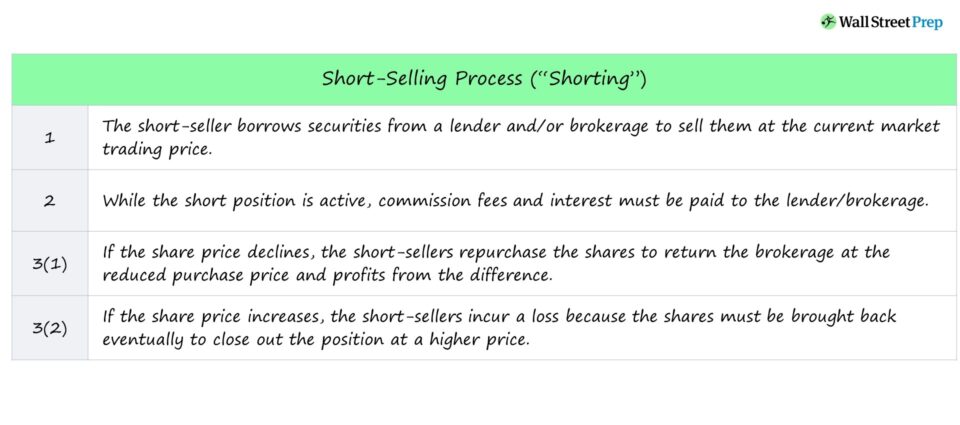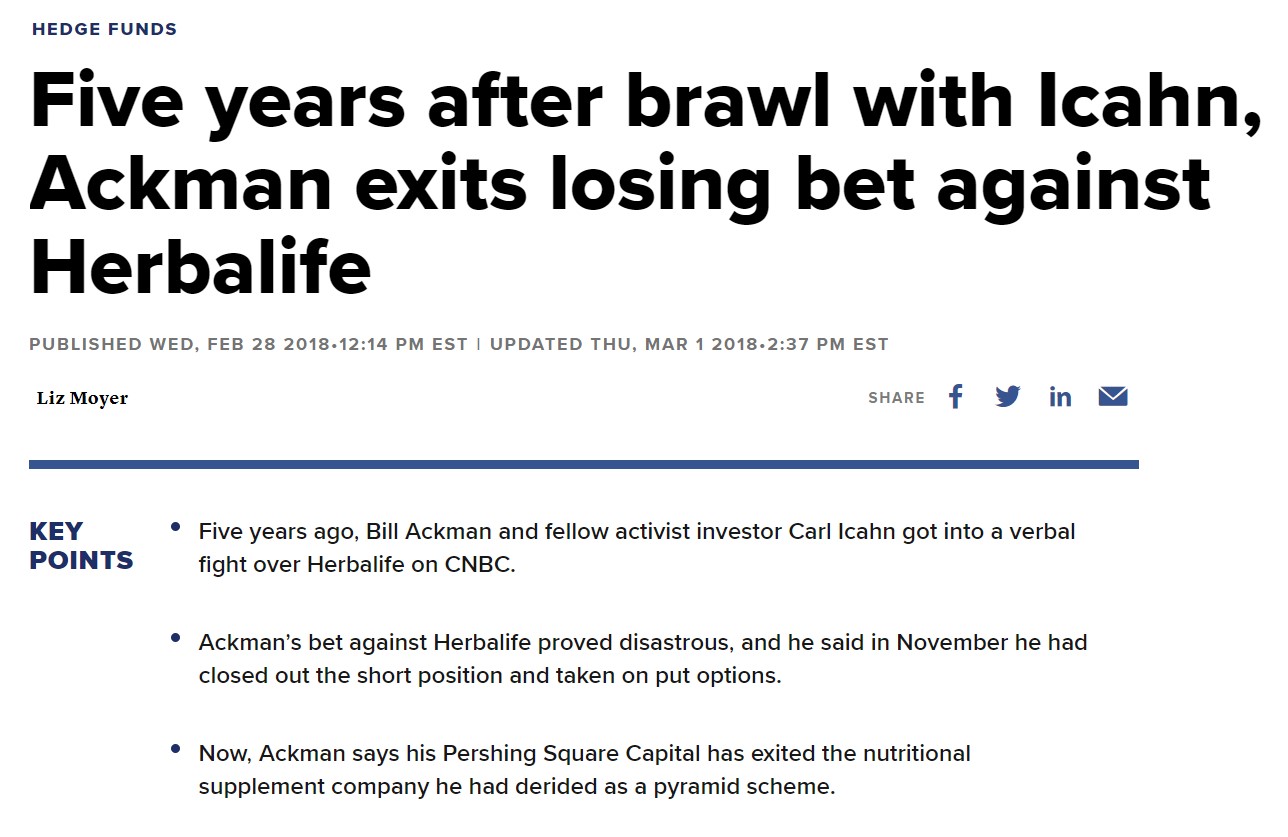- What is Short Selling?
- How Does Short Selling Work?
- What are Commitment Fees and Margin Account?
- How is Short Selling an Example of Hedging?
- What is an Example of Short-Selling?
- What are the Risks to Short Selling Stocks?
- How Does Short-Selling Impact the Stock Market?
- Examples of Successful Shorts
- Examples of Failed Shorts
What is Short Selling?
Short Selling is the process by which an investor sells borrowed securities from a brokerage in the open markets, expecting to repurchase the borrowed securities at a lower price, at a profit.

How Does Short Selling Work?
If an investment firm has taken a short position, the firm has borrowed securities from a lender and sold them at the current market trading price.
The opposite of going “short” is going “long”, which means the investor believes the share price will increase in the future.
If the share price declines as projected, the firm buys back the shares at a later date, at the reduced share price – returning the applicable amount back to the original lender and keeping the remaining profits post-fees.
So, why might an investor short-sell a company’s stock?
The short-selling firm is under the belief that share prices will soon decrease.
- Declining Stock Price ➝ The short-sellers repurchase the shares to return them to the brokerage at the reduced purchase price and profit from the difference.
- Rising Stock Price ➝ The short-sellers incur a loss because the shares must be bought back eventually to close out the position at a higher price.
Learn More → Hedge Fund Quick Primer
What are Commitment Fees and Margin Account?
Throughout the time in which the short position is active, commission fees and interest must be paid to the brokerage/lender.
Another requirement from the brokerage/lender is a margin account (i.e. maintenance margin), which is the minimum equity required to be held by the short seller post-transaction.
The margin account must maintain 25%+ of the total securities’ value, otherwise, an unmet threshold can result in a “margin call” where the positions must be liquidated.
The Wharton Online & Wall Street Prep Applied Value Investing Certificate Program
Learn how institutional investors identify high-potential undervalued stocks. Enrollment is open for the Feb. 10 - Apr. 6 cohort.
Enroll TodayHow is Short Selling an Example of Hedging?
Short selling is a speculative investment strategy, which should only be executed by more experienced investors and institutional firms.
Certain firms will utilize short selling to hedge their portfolio in case of an unexpected downturn, which protects the downside risk of their long positions.
Therefore, while many short sellers attempt to capitalize and profit from the collapse of a company’s share price, others can short sell to hedge against volatility in their portfolio of securities ((i.e. reduce exposure to their existing long positions).
For instance, if a large number of a hedge fund’s long positions have declined, the fund might have taken out a short position in related stocks or even the same stocks.
In effect, rather than the entire portfolio being down, the profits from the short can help offset some of the losses.
What is an Example of Short-Selling?
Let’s say that an investor believes that a company’s shares, which are currently trading at $100 per share, will decline.
To short the company’s stock, the investor borrows 100 shares from a brokerage and sells those shares in the market, which are technically not owned by the firm.
Later, if the company’s share price declines to $80 post-earnings release (or another catalyst), the investor can close the short position by repurchasing 100 shares in the open market at a price of $80 per share.
Those shares, as part of the agreement, are then returned to the brokerage.
In our example scenario, the investor has made a profit of $20 per share before interest and fees – which comes out to a total profit of $2,000 for the 100 shares of the short position.
Note: For purposes of simplicity, we ignore the commissions and interest paid to the brokerage.
What are the Risks to Short Selling Stocks?
The major risk to short selling – and why most investors should avoid short selling – is that the potential downside is theoretically unlimited since the upside on a share price increase is uncapped.
Short sellers are betting that the security’s price will decline, which can be profitable if correct, but also losses can mount rapidly if not.
It is important to note that the shares sold do NOT belong to the short seller, as they were borrowed from a broker/lender.
Therefore, regardless of whether the share price has dropped as hoped (or increased), the short seller must repurchase the shares.
Closing a short position can be up to the short seller, however, certain brokers/lenders will include provisions requiring the return of funds if requested in a margin call.
How Does Short-Selling Impact the Stock Market?
Short sellers often get a negative reputation from the market, as many view them as intentionally ruining the reputation of a company to profit from the decline in price.
The market contains a long-term upward bias, making the odds stacked against short sellers, as confirmed by the historical growth rates of the S&P 500 since the 1920s.
But the reality is short selling provides increased liquidity in the market, allowing the markets to function orderly.
Many notable investors, such as Seth Klarman and Warren Buffett, have publicly agreed that short selling helps the market.
- Klarman stated that short sellers can help counter irrational bull markets (i.e. healthy skepticism).
- Buffett also views short-sellers positively as they often uncover fraudulent accounting practices among other unethical behaviors.
The latter point leads to our next discussion topic, which is the number of frauds exposed by short-sellers.
Examples of Successful Shorts
Enron, Housing Crisis (CDS), Lehman Brothers and Luckin Coffee
Short specialists dedicate their time researching potentially fraudulent companies and then publicizing their findings often in research reports, which can deter unknowing investors from purchasing those stocks.
- Jim Chanos (Kynikos Associates) – Enron Corporation
- Michael Burry (Scion Capital) – Credit Default Swaps (CDS), i.e. Inverse Returns as Mortgage-Backed Securities
- David Einhorn (Greenlight Capital) – Lehman Brothers
- Carson Block (Muddy Waters Research) – Luckin Coffee
Examples of Failed Shorts
Herbalife, Shopify, GameStop
- Bill Ackman (Pershing Square) – Herbalife
- Gabe Plotkin (Melvin Capital) – GameStop
- Andrew Left (Citron Research) – Shopify
Ackman’s short of Herbalife, a highly publicized activist campaign, was unprecedented in terms of the press coverage, duration, and total costs incurred.
Ackman accused Herbalife of running a pyramid scheme and placed a massive bet that its share price would drop to zero, but after promising signs of early success, the share price later recovered.

The failed short position was due to the backing of many institutional firms and one investor, Carl Icahn – who had an on-air verbal debate with Bill Ackman on CNBC.
Eventually, Ackman threw in the towel on the disastrous short where his firm lost in excess of $1 billion, demonstrating the difficulty and multiple moving pieces in a high-risk, public short position.






